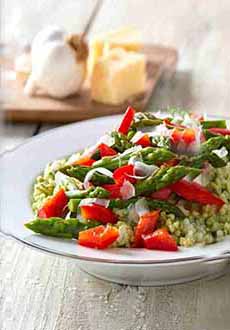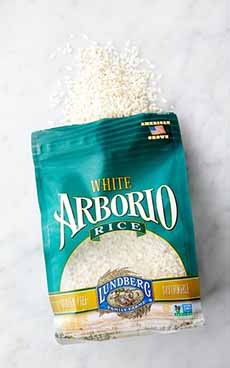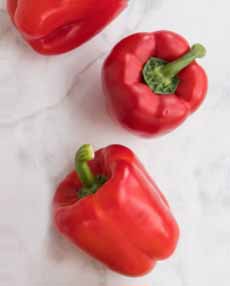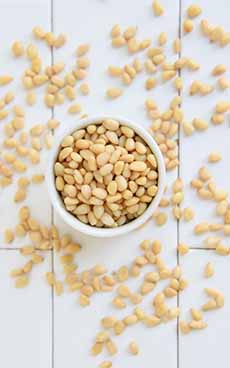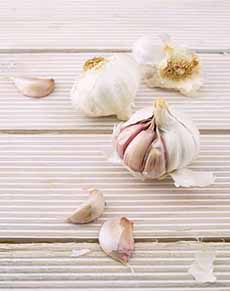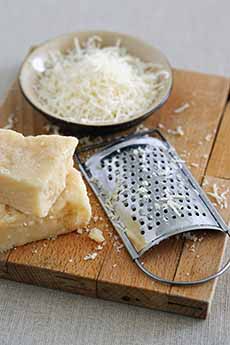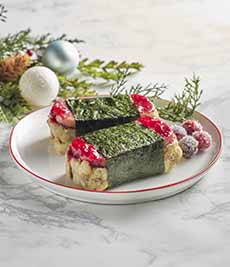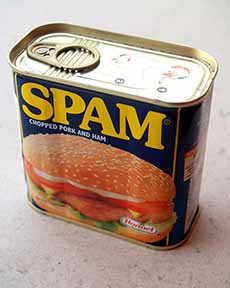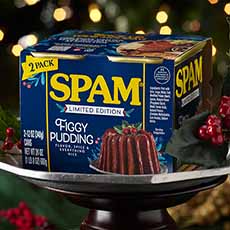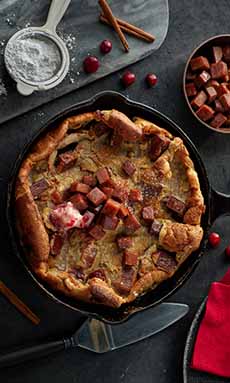|

[1] Delicious salted cod with tomatoes, capers, olives, and red pepper flakes (photos #1, #2, #5, #8, and #9 © DeLallo).

[2] A box of salt cod, ready for soaking.
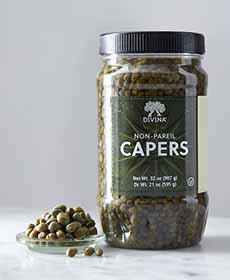
[3] Non-pareil capers are the smallest and most delicate in flavor (photos #3 and #6 © Good Eggs).
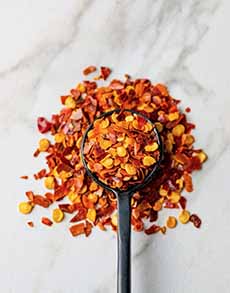
[4] Crushed red pepper flakes (photo © Savory Spice Shop).

[5] Crushed San Marzano tomatoes.
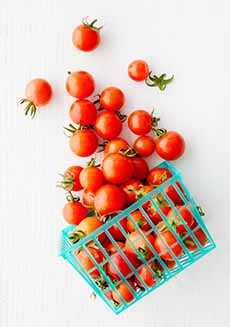
[6] Whole cherry tomatoes will burst in the oven, adding their juices to the sauce..
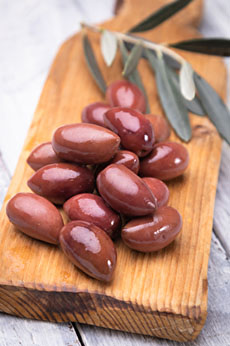
[7] Pitted Kalamata olives (photo Igor Dutina | Panther Media).
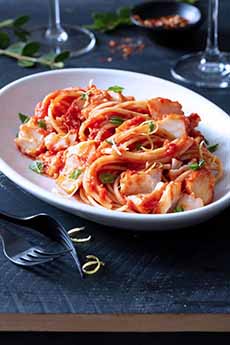 Baccala With Linguine[/caption] Baccala With Linguine[/caption]
[8] Baccalà In Tomato Sauce With Linguine Here’s the recipe.

[9] Soda Battered Baccalà With Sour Cream & Caper Sauce.
|
|
If you’re not Italian-American, you may not know the tradition of the Feast Of The Seven Fishes.
But there’s no time like Christmas Eve to begin the tradition: a dinner consisting of seven seafood dishes. (Some ambitious families go for eight, nine or more dishes).
> We’re starting you off with a heritage salt cod recipe, below.
> Also below, instead of Italian fare you can serve an all-American seafood menu.
> After you’ve gotten the hang of salted cod, here are more recipes.
THE HISTORY OF THE FEAST OF THE SEVEN FISHES
The Feast of the Seven Fishes (in Italian, Festa Dei Sette Pesci) is an Italian-American celebration on Christmas Eve: a feast with dishes of fish and other seafood.
In Southern Italian tradition, Christmas Eve is a vigil or fasting day that is known as La Vigilia (The Vigil). An all-seafood meal reflects the observance of abstinence from meat until the feast of Christmas Day.
The celebration commemorates the wait, the Vigilia di Natale, for the midnight birth of the baby Jesus [source].
The long-standing practice of eating seafood on Christmas Eve dates from the Roman Catholic tradition of abstaining from eating meat on Fridays and specific holy days, including the eve of a feast day (e.g., Christmas).
It dates to medieval times. Since no meat or animal fat could be used on abstinance days, observant Catholics ate fish, typically fried in oil.
Among Italian-Americans, the Christmas Eve observation turned into a grand dinner with seven or more traditional Italian fish dishes.
It’s definitely an American custom: The name “seven fishes” and the presentation of seven dishes as both a concept and a name is unknown in Italy.
However, the fare comprises traditional dishes from the old country: baccalà (salted cod fish), calamari, and fried fish and seafood (oysters, scallops, shrimp, smelts).
There is no historical agreement as to the origin of the number seven. It may come from the seven Sacraments of the Catholic Church. We may have to wait for the next Dan Brown novel to uncover the mystery.
HOW YOU CAN CELEBRATE OF THE FEAST OF THE SEVEN FISHES
It you’d like to try creating your own seven fish dishes on Christmas Eve, you don’t have to adhere to Italian specialties or make a full dinner out of it. See our suggestions below.
You can even do it as a potluck, or as an appetizer plate with, for example, calamari salad, cocktail shrimp, crab cakes, crab dip with crudités, tuna-olive tapenade, seafood paté and smoked salmon or gravlax.
Have we convinced you yet to make the Feast Of The Seven Fishes a holiday tradition in your home?
Below is a classic recipe to get you started, featuring baccalà (salted cod), a traditional Italian ingredient [photo #2].
The salted cod is sautéed with crushed tomatoes, capers, olives, and lemon juice before roasting it in the oven with whole tomatoes until the tomatoes start to burst.
WHAT YOU NEED TO KNOW ABOUT SALTED COD
Says Italian food specialist DeLallo, who provided us with the following recipe:
“Baccalà comes mostly from the coasts of Labrador and Newfoundland, where it’s fished, salted [to preserve it] and exported all over the world.
[While] dried and salted fish doesn’t sound like something to get too excited about…if you ask an Italian about [it] you’ll see their eyes light up.
“Salt-dried cod has been used in Mediterranean recipes for thousands of years and it has become a Christmas Eve favorite for many traditional Italian families.
“Salt-dried cod is delicious when prepared correctly. It’s slightly firm and mild in flavor, and it pairs well with acidic flavors, such as tomatoes, marinated artichokes, and capers.”
RECIPE: SALTED COD WITH TOMATOES, CAPERS, & OLIVES
Preparation includes soaking the cod for three days in advance of cooking, to remove the salt. Here’s how.
Soaking time is 3 days, prep time is 10-15 minutes, cook time is 50 minutes.
Ingredients
2 pounds center-cut skinless boneless salt cod (baccalà), prepared (directions below)
3 tablespoons extra virgin olive oil
1 medium onion, diced
1 (4-ounce) jar non-pareil* capers, drained**
4½ teaspoons red pepper flakes
1 (28-ounce) can San Marzano-style crushed tomatoes‡
1 teaspoon salt
20 cherry tomatoes
½ pound pitted Kalamata olives
1 lemon, halved
Bunch fresh basil, chopped
Preparation
1. PREPARE and soak the baccalà at least 3 days prior cooking. Here’s how to do it.
2. HEAT the oven to 375°F.
3. HEAT 3 tablespoons of olive oil over medium heat in a cast iron or oven-safe skillet, until hot but not smoking. Add the onion and sauté until golden, 3 to 4 minutes.
4. ADD the red pepper flakes, capers, San Marzano tomatoes and salt. Bring to a boil and simmer for 20 minutes.
5. ADD the cod, olives, cherry tomatoes, juice from lemon halves and the lemon. Transfer to the oven and roast until fish becomes brown and tomatoes start to blister, about 20 to 25 minutes.
6. REMOVE from the oven and serve.
ALL-AMERICAN GOURMET SEVEN FISHES MENU
For a gourmet Feast Of The Seven Fishes, consider this seven-course dinner:
Oyster shooters, oysters on the half shell, or Oysters Rockefeller.
Salmon or tuna tartare or ceviche.
Seafood chowder.
Marinated seafood salad (calamari, octopus, shrimp, green and black olives, onion) over greens.
Angel hair pasta with lobster in a tomato cream sauce or squid ink pasta with scallops and red caviar.
Your favorite salmon dish.
Your favorite shrimp recipe or lobster dish.
Last year, as a starter with cocktails we served salmon, tuna, and eel sushi rolls from our neighborhood sushi bar.
MORE RECIPES WITH SALTED COD (BACCALÀ)
Baccalà In Tomato Sauce With Linguine
Fried Baccalà
Mrs. DeLallo’s Baccalà Salad
Oven-Roasted Baccalà With Potatoes
Soda Battered Baccalà With Sour Cream & Caper Sauce
________________
*Non-pareil is a French term meaning “has no equal.” Non-pareil capers are the smallest caper buds, measuring under 7mm. They are considered the most delicate with a tighter, firmer texture, and the most elegant in appearance.
**You can repurpose the liquid in a vinaigrette.
†Each caper type is determined by when the caper is picked. Nonpareils are the most popular and only grow to 7 millimeters. Surfines grow between 7 to 9 millimeters, Capucines grow 9 to 11 millimeters, Capotes grow 9 to 11 millimeters, Fine grow 11 to 14 millimeters, and Grusas grow anything over 14 millimeters [source]. While non-pareil capers are often advertised as the highest quality, the flavor profiles of various caper sizes are a matter of personal taste. Smaller buds have a more subdued flavor than those that are later in the blooming stage [source].
‡Roma tomatoes, also known as plum tomatoes, are oblong and have few seeds. Kumato tomatoes have a stronger, harder skin than a regular tomato that resists bruising. A hybrid variety, it ripens to a deep greenish brown.
|
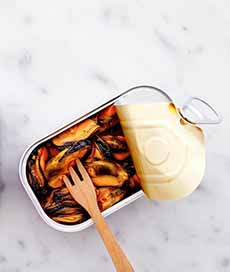

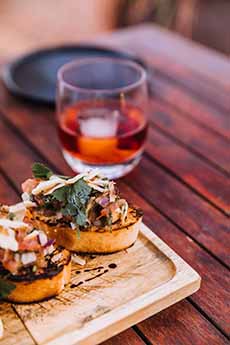



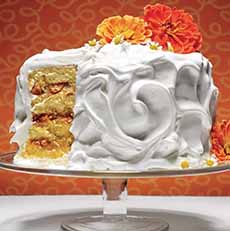





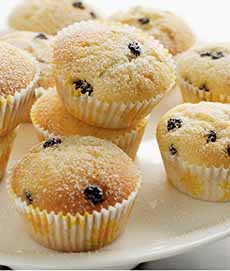







 Baccala With Linguine[/caption]
Baccala With Linguine[/caption]
